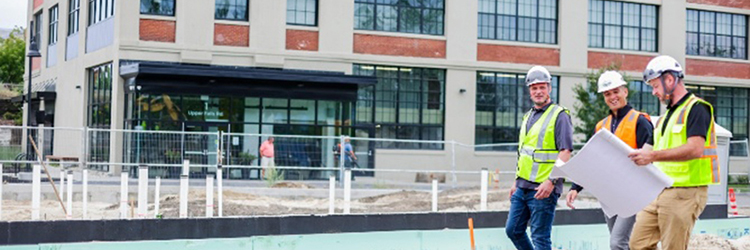The New Hampshire economy keeps chugging along... but for how long? - by David De Lise

Coming into 2020, the national economy has been on an extended upward trajectory for more than a decade. Housing prices are up, wage growth has been reasonable and the threats of inflation have been muted for an extended period; the Federal Reserve continues to provide stimulus to maintain and/or enhance consumer confidence and encourage consumer spending. These are all strategies that helped bolster the economy when it needed it most: the post 2008/2009 financial crisis.
Any conversation revolving around our economic opportunities has to start with our workforce and our housing options. New Hampshire has long been referred to as a graying state. Yes, the state has more folks at or near retirement age than they have new-to-the-workforce population counts. This isn’t a New Hampshire-isolated trend, however. The aging of America is not a new phenomenon; it is happening right before our eyes. 10,000 folks each day reach retirement age in the United States. Let’s not forget to consider how the internet affects consumer shopping and housing preferences of Gen Z, Gen X and elderly renters, as well as the rest of the rent by need and rent by choice prime age cohorts.
In New Hampshire we struggle to provide attractive, affordable housing solutions for the young, the middle class and the elderly. These workers need a variety of housing options with a lot of different amenities, necessities and price points. It’s not a one-size-fits-all solution we’re looking for. Without a deep labor pool, the stores/restaurants/service providers can’t find or hire the staff they need to sufficiently fill available positions at a wage deemed acceptable to workers, which affects their operations. A suggestion of “just pay the workers more” isn’t always a viable nor fiscally responsible solution. Without affordable, safe, secure housing options, these same workers are fleeing New England (and especially New Hampshire) for states that are ahead in terms of job creation, wage growth, cost-of-living attractiveness and the variety of newly built housing options. The housing situation in New Hampshire, coupled with a lack of available workers, impacts everyone who owns a business in New Hampshire. It also impacts companies from out of state that love the quality of life that NH is well-known for and who may have an interest in relocating here.
A look at some recently released stats and figures regarding the State of New Hampshire’s employment and housing situation reveals that these issues may be larger than what most of us acknowledge.
For starters, total employment statewide is estimated at 652,919 (reflects May 2019 data - the most current information available at the time of writing). The unemployment rate in October 2019 was 2.6%. This same rate held through January 2020 at 2.6%. Looking back one year to January 2019, the unemployment rate was 2.5%. This rate gives New Hampshire the sixth (6th) lowest rate of unemployment in the nation. The unemployment rate for all of the United States currently stands at 3.6%. Looking back to January 2018, the unemployment rate for the U.S. stood at 4.1% while New Hampshire was at 2.7%. New Hampshire has been trending more favorably than the U.S. as a whole for an extended period of time in regards to employment and unemployment. All of this sounds good, doesn’t it?
Now, let’s look at some housing numbers. The average monthly rent in the United States fell by $1 per s/f. in December 2019 to $1,474.00, with the growth rate falling 10 basis points from November. Multi-family rental rates in the U.S. closed out 2019 up 3%. Year-over-year growth remained between 3% and 3.3% for the entire year. Rental rates were essentially flat for the fourth quarter of 2019, which is a normal seasonal trend. The last time that rents grew significantly during the fourth quarter was 2015 and 2016. 300,000 new units were delivered nationwide in 2019, with a stabilized occupancy rate right around 94.9% as of November, down just 10 basis points over the previous year. According to a report from Freddie Mac, producing in excess of 300,000 multi-family housing units annually still left a shortfall of approximately 300,000 units annually. A healthy job market averaging 180,000 new jobs per month, and an unemployment rate of 3.5% helped produce steady absorption throughout 2019 heading into 2020.
In New Hampshire, the median monthly gross rent in 2019 was $1,437 with a vacancy rate of LESS THAN 1% (0.75% to be precise). The percentage change in rent reflects an increase of 3.9%. The statewide median gross rent (including utilities) for a 2-bedroom apartment unit has increased more than 20% during the past 5 years. Coos County has a median monthly gross rental cost for a 2-bedroom unit at $820.00; Grafton County comes in at $1,217 per month and Rockingham County is at $1,568 per month. When you look at vacancies in these same counties, Coos County has a vacancy rate of 1.1%, Grafton County is at less than 1% and Rockingham County also has less than a 1% vacancy rate.
New Hampshire is blessed (or cursed) with really low unemployment AND very low multi-family vacancy rates, with median monthly rental rates on par with the whole of the United States. Is this sustainable? Is it realistic to expect our recent college graduate workforce, our elderly workforce or our tireless hourly workers to sustain paying these rental rates which often exceed the traditional benchmark of “no more than 30% of your adjusted gross income should be allocated towards rent & utilities”?
In New Hampshire, 75% of all multi-family housing units are located in Hillsborough, Rockingham, Merrimack and Strafford counties. From 2010-2013, New Hampshire delivered +/- 10,134 units of multi-family housing, however, since 2014 only +/- 3,681 units of multi-family housing have been constructed. At a recent housing conference, economist Russ Thibeault stated that we need 20,000-30,000 MORE housing units to meet the demand of New Hampshire’s housing needs and continued economic growth. These numbers reflect the need for ALL types of housing to be built in New Hampshire, not just multi-unit housing options.
Housing undersupply in the United States is expected to worsen this decade as Millennial and Gen Z populations form new households. This is in addition to addressing the expanding challenges of providing affordable housing solutions for our elderly. As our population continues to experience a variety of housing lifestyle preferences whether it be to age in place, live in appealing live-work-play communities or have access to bustling 24-hour cities, housing options for every age group need to broaden and expand to attract and retain the hardworking, loyal workers in the country. We all have a vested interest in devising housing solutions for our beloved NH population - as real estate professionals, as business owners and as civic leaders. We owe it to our colleagues and co-workers; to our children and grandchildren; and to our elderly who rely on us to provide exciting new housing solutions which keep them safe, secure and happy. At Berkshire Hathaway HomeServices Verani Realty, we embrace these challenges and we look forward to working together to make 2020 the year of change!
David De Lise, MiCP, is the director of the commercial division at Berkshire Hathaway Verani Realty, Londonderry, N.H.
Reveler Development celebrates final phase of work at The Levee - new 51-unit apartment building in Biddeford


The Greater Portland industrial mid-year market update - by Nate Roop

Maine multifamily outlook: Opportunities in Portland, Bangor, and Lewiston-Auburn - Blake Wright and Kristie Russell
The multifamily market in Maine’s major cities presents a diverse range of opportunities for investors. We looked at the potential benefits and unique characteristics of three major submarkets in the state: Portland, Bangor, and Lewiston-Auburn. The information below is based on research done in CoStar and county registries, and focuses on multifamily properties that have four or more units.

Interest rates and inflation - by Matthew Bacon
As we all know, interest rates have been changing drastically, with movement in both directions, depending on the type and term of financing. The Federal Open Market Committee has taken drastic action in efforts to curb abnormally high inflation, but it hasn’t controlled labor cost growth to the extent that was intended.


 (1) (1).png)





.png)


.png)